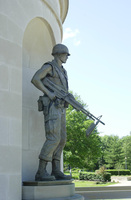 | Back to e-WV
| Back to e-WV
 The West Virginia Encyclopedia
The West Virginia Encyclopedia
 | Back to e-WV
| Back to e-WV
 The West Virginia Encyclopedia
The West Virginia Encyclopedia

The undeclared Vietnam War lasted from 1965 to 1973. U.S. intervention began after the French withdrew in 1954 in the face of a growing Communist insurgency. During the Kennedy administration, the American military presence grew from several hundred advisers to more than 15,000. After the 1964 Gulf of Tonkin incident, Congress granted broad war powers to President Johnson, who escalated the conflict through a bombing campaign against North Vietnam.
Opposition to the war grew as the death toll increased. Many Americans resisted the draft, while college demonstrations focused youthful rebellion against the war. Nonetheless, President Nixon expanded strategic bombing raids to nearby Laos and Cambodia, before announcing a withdrawal strategy in 1970. In early 1973, the last Americans evacuated South Vietnam, which fell to the North in 1975. More than three million U.S. military personnel served in Indochina, and Americans suffered more than 57,000 casualties.
As in other wars, West Virginians did more than their share in Vietnam. A total of 36,578 West Virginians served, with 1,182 killed. The Adjutant General Department estimated the state suffered a 2.75 death rate per 10,000 citizens in 1969, as compared to a national average of 1.80, while another source indicates a West Virginia death rate of 8.41 per 10,000 residents for the war as a whole compared to a national rate of 5.89. Nine West Virginians received Medals of Honor, including Thomas W. Bennett (1947–69), a conscientious objector who served as a noncombatant medic and died saving others on the battlefield. Several Vietnam memorials commemorate the sacrifices of West Virginians in Vietnam, notably the West Virginia Veterans Memorial in Charleston.
There was an active home front effort in West Virginia, as well. Charleston Ordnance Center built armored vehicles for the U.S. Army, while ROTC programs at state colleges and universities graduated many junior officers. Many West Virginians supported the Vietnam War, while others contributed to the resistance. Students demonstrated on campuses across the state. At West Virginia University student publications reflected strong opposition from a campus generally perceived as relatively conservative. WVU demonstrations reached a tense standoff on May 7–8, 1970, after the killing by National Guard troops of student demonstrators at Kent State University. On the second day, Morgantown police brokered a truce between state troopers and activists occupying Grumbein’s Island and University Avenue in the heart of the downtown campus. Protests were staged in West Virginia communities as well, including a major rally in Charleston in October 1969.
Written by Jeffrey M. Leatherwood
Doherty, William T. & Festus P. Summers. West Virginia University: Symbol of Unity in a Sectionalized State. Morgantown: West Virginia University Press, 1982.
Simons, Donald L. I Refuse: Memories of a Vietnam War Objector. Trenton, NJ: Broken Rifle Press, 1992.
Snyder, Dorothy B. Not to be Forgotten: Prestonians Who Died in Vietnam 1965-1970. Dover, DE: Dorothy B. Snyder, 2001.
Young, Marilyn B. The Vietnam Wars 1945-1990. New York: Harper- Collins, 2001.
Fullerton, Robert. One Man's Relevancy: The Case of Tom Bennett. West Virginia University Magazine, (Spring 1971).
West Virginia University Magazine, (Spring & Summer 1969, Summer & Winter 1970).
West Virginia Casualties in Vietnam. Charleston: State Adjutant General's Office, 6/30/1969.
West Virginia Casualties in Vietnam. Charleston: State Adjutant General's Office, 12/31/1971.